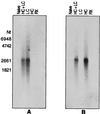Coexpression of factor VIII heavy and light chain adeno-associated viral vectors produces biologically active protein
- PMID: 10535990
- PMCID: PMC23069
- DOI: 10.1073/pnas.96.22.12725
Coexpression of factor VIII heavy and light chain adeno-associated viral vectors produces biologically active protein
Abstract
We are interested in using recombinant adeno-associated viral vectors in the treatment of hemophilia A. Because of the size constraints of recombinant adeno-associated viral vectors, we delivered the heavy and light chains of the human factor 8 (hFVIII) cDNA independently by using two separate vectors. Recombinant AAV vectors were constructed that utilized the human elongation factor 1alpha promoter, a human growth factor polyadenylation signal, and the cDNA sequences encoding either the heavy or light chain of hFVIII. Portal vein injections of each vector alone, a combination of both vectors, or a hFIX control vector were performed in C57BL/6 mice. An ELISA specific for the light chain of hFVIII demonstrated very high levels (2-10 microgram/ml) of protein expression in animals injected with the light chain vector alone or with both vectors. We utilized a chromogenic assay in combination with an antibody specific to hFVIII to determine the amount of biologically active hFVIII in mouse plasma. In animals injected with both the heavy and light chain vectors, greater than physiological levels (200-400 ng/ml) of biologically active hFVIII were produced. This suggests that coexpression of the heavy and light chains of hFVIII may be a feasible approach for treatment of hemophilia A.
Figures





References
-
- Sadler J, Davie E W. Hemophilia A, Hemophilia B, and von Willebrand’s Disease. Philadelphia: Saunders; 1987.
-
- Furie B, Limentani S, Rosenfield C. Blood. 1994;84:3–9. - PubMed
-
- Lofqvist T, Nilsson I M, Berntorp E, Pettersson H. J Int Med. 1997;241:395–400. - PubMed
-
- Ragni M V, Hord J D, Blatt J. Haemophilia. 1997;3:90–95. - PubMed
MeSH terms
Substances
LinkOut - more resources
Full Text Sources
Other Literature Sources

